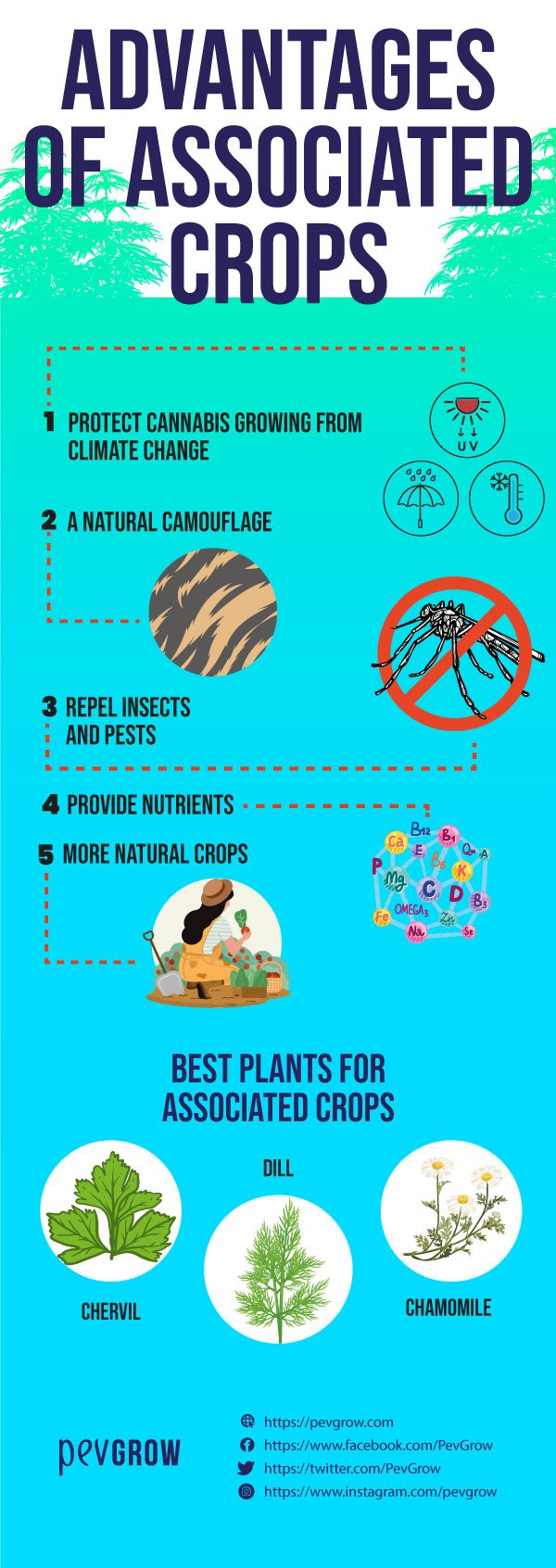

In constant struggle for the regulation of cannabis, mainly in the medicinal field.
08-12-2020 10:00:16 - Updated: 8 December, 2020
Have you considered growing associated plants with your cannabis crop? This could considerably improve the quality of the soil and become a new source of nutrients for cannabis. With this technique you get different benefits such as pest control without the need for pesticides or the natural camouflage of marijuana itself.
When a producer decides to have a cultivation of cannabis, it is usual that he/she chooses to devote himself/herself exclusively to this plant. But having a monoculture may not be the best strategy when it comes to keeping the soil in good condition. To have associated plants can give a greater effectiveness to the culture in the long term and result in a stronger and healthier cannabis.
With the use of another type of plants, it is possible to improve the sustainability of the cannabis culture so that it is more durable, to get more intense flavors and, definitively, to obtain much more natural crops.
This sounds interesting, Do you want to know more ?😜👉
👌 What is an associated crop ?
This method is based on cultivating another type of plants next to the cannabis crop and it is not an innovation, since it is a practice with thousands of years of experience in gardening and from which any culture of cannabis can also benefit.
Faced with the need to take advantage of space to obtain a greater yield from cannabis plants, growers usually have a structure in the form of a monoculture, that is, they only plant this variety in the place intended for it. Changing this formula for polyculture is very simple, it can be applied both indoors and outdoors and offers a number of advantages not negligible. It is enough to add other types of species and start to obtain better results without the need to make a big investment.
🚀 Advantages of associated crops
-Protect cannabis growing from climate change
If you choose to make a crop associated with plants of a larger size, these can become a natural barrier against external aggressions. When winds and storms appear, they will offer protection to the cannabis crops and in the hottest days, they will shade the small plants, which will be less affected by this weather. They will become a source of refuge regardless of the type of weather conditions in which the crop is located.
-A natural camouflage
Many producers decide to have their crops outdoors because they have more space, they have that possibility and it gives them more comfort in the maintenance of the plants. They often prefer that cannabis plants go unnoticed in these cases and a good way to achieve this goal is with associated crops, which will not make the plantation so visible and will get little attention. If in addition this new vegetation has certain physical similarity with cannabis it will be much more difficult for any intruder to distinguish it at first sight.
-Repel insects and pests
There is nothing better than a natural repellent to keep a crop free of pests or insects without damaging it and that is precisely what the method of associated crops can provide. There are certain varieties that naturally expel repellent substances, especially aromatic herbs, and that will keep cannabis plants safe without the need to apply chemical solutions that are harmful to their development. In other cases, you can also benefit from insects that feed on larvae, if you choose to plant varieties that produce pollen and attract mantis or ladybugs.🐞
-Provide nutrients
One of the most important factors in maintaining a crop in good condition is the conservation of soil quality. Associated crops can be crucial to improve this condition since they will be able to maintain the humidity longer and help the drainage of the soil. In addition, some plants have certain bacteria capable of capturing the nitrogen present in the air to later fix it in the soil, offering higher levels of this element to the soil and better preserving its characteristics. Others work as natural fertilizers and provide the optimal minerals for healthy crop growth.
-More natural crops
In nature you can find different varieties of plants living together in the same space, so practicing monoculture is not exactly a method associated with the natural course of plant growth. Moreover, they often bring different problems caused by the appearance of pests or the deterioration of the soil itself. By practicing polyculture a more natural ecosystem is obtained and the use of pesticides is avoided, encouraging plants to grow as they would do without the assistance of producers.

✅ Best plants for associated crops
Depending on the type of plants chosen, the associated crops can bring some benefits or others to the maintenance of cannabis. Varieties such as chervil are great growth enhancers and are able to repel some harmful insects such as slugs. Dill is one of those plants capable of attracting bees or wasps that feed on insects that are not very beneficial for the crop and others like chamomile are great nutrient contributors to improve the quality of the soil.
Ideally, in order to create a good associated crop, it is necessary to look for the right strategy and choose those plants that are going to replace the producer’s hand, the chemical additives and enhance those elements necessary for the success of the cannabis crops.
🎯 Conclusion
Cannabis crops are usually produced as monocultures and this can be not very beneficial for the quality of the soil and the growth of the plants. Using the associated cultivation method has several advantages, such as protection against climatic changes or the natural barrier against insects and pests.
When larger associated plants are grown, they protect the cannabis crop from wind, rain or excessive heat. On the other hand, some of them act as a repellent against the appearance of destructive insects or devastating pests. By providing new minerals, the soil will be in better condition and cannabis growth is likely to be more successful. In addition, if you seek to hide a culture outdoors, the appearance of other varieties can perfectly camouflage cannabis.
To choose the right plants with which to use this technique, you must think about what is most beneficial for the crop, since some varieties have more advantages when it comes to protecting against insects and others are a source of minerals which will lead to the prosperity of the soil.
It’s time to look for the plant that best fits your needs and interests 🧐 and find the right place to watch them grow.👍





